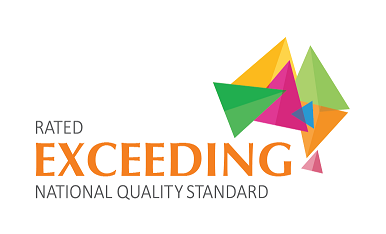Children's Illness
Children will need to stay away from the service if they are unwell or have an infectious disease and can only return to the service if they are completely well. If your child is unwell while at the service, you will be contacted and may be required to collect them as soon as practical.
Families may need to provide a written clearance letter from a doctor (GP or specialist) as requested by the Nominated Supervisor or Person-s in Day-to-Day Charge for their child to return to the service if they have been unwell or have had an infectious disease. Please see our policy Dealing with Illness and Infectious Diseases Policy.
We follow the Department of Health infectious diseases exclusion table for primary schools and children’s services for guidance of exclusion periods. All families will be notified if there has been an infectious disease notification within the service.
Please inform the service if your child has been unwell.
Infectious Diseases Control — Exclusion Table:
The following table indicates the minimum period of exclusion from children’s service centres as prescribed under Public Health and Wellbeing Regulations 2019 — Schedule 7.
| Conditions | Exclusion of cases | Exclusion of contacts |
|---|---|---|
| Chicken pox | Exclude until all blisters have dried. This is usually at least 5 days after the rash appears in unimmunised children, but may be less in previously immunised children. | Any child with an immune deficiency (for example, leukaemia) or receiving chemotherapy should be excluded for their own protection. Otherwise not excluded |
| Conjunctivitis | Exclude until discharge from eyes has ceased | Not excluded |
| Cytomegalovirus (CMV) Infection | Exclusion is not necessary | Not excluded |
| Diarrhoeal Illness* | Exclude until there has not been vomiting or a loose bowel motion for 24 hours | Not excluded |
| Diphtheria | Exclude until medical certificate of recovery is received following at least two negative throat swabs, the first not less than 24 hours after finishing a course of antibiotics and the other 48 hours later | Exclude family/household contacts until cleared to return by the Chief Health Officer |
| Glandular fever (Epstein-Barr Virus infection) | Exclusion is not necessary | Not excluded |
| Hand, Foot and Mouth disease | Exclude until all blisters have dried | Not excluded |
| Haemophilus influenzae type b (Hib) | Exclude until 48 hours after initiation of effective therapy | Not excluded |
| Hepatitis A | Exclude until a medical certificate of recovery is received, but not before 7 days after the onset of jaundice or illness | Not excluded |
| Hepatitis B/ Hepatitis C | Exclusion is not necessary | Not excluded |
| Herpes (‘cold sores’) | Young children unable to comply with good hygiene practices should be excluded while the lesion is weeping. Lesions to be covered by dressing, where possible | Not excluded |
| Human immuno-deficiency virus infection (HIV) | Exclusion is not necessary | Not excluded |
| Impetigo | Exclude until appropriate treatment has commenced. Sores on exposed surfaces must be covered with a watertight dressing | Not excluded |
| Influenza and influenza like illnesses | Exclude until well | Not excluded unless considered necessary by the Chief Health Officer |
| Leprosy | Exclude until approval to return has been given by the Chief Health Officer | Not excluded |
| Measles | Exclude for at least 4 days after onset of rash | Immunised contacts not excluded. Unimmunised contacts should be excluded until 14 days after the first day of appearance of rash in the last case. If unimmunised contacts are vaccinated within 72 hours of exposure with any infectious case, or received Normal Human Immunoglobulin (NHIG) within 144 hours of exposure of any infectious case, they may return to the facility |
| Meningitis (bacteria, other than meningococcal meningitis) | Exclude until well | Not excluded |
| Meningococcal infection | Exclude until adequate carrier eradication therapy has been completed | Not excluded if receiving carrier eradication therapy |
| Mumps | Exclude for 5 days or until swelling goes down (whichever is sooner) | Not excluded |
| Molluscum contagiosum | Exclusion is not necessary | Not excluded |
| Pertussis (whooping cough) | Exclude for 21 days after the onset of cough or until they have completed 5 days of a course of antibiotic treatment | Contacts aged less than 7 years in the same room as the case who have not received three effective doses of pertussis vaccine should be excluded for 14 days after the last exposure to the infectious case, or until they have taken 5 days of a course of effective antibiotic treatment |
| Poliovirus infection | Exclude for at least 14 days from onset. Re-admit after receiving medical certificate of recovery | Not excluded |
| Ringworm, scabies, pediculosis (head lice) | Exclude until the day after appropriate treatment has commenced | Not excluded |
| Rubella (German measles) | Exclude until fully recovered or for at least 4 days after the onset of rash | Not excluded |
| Severe Acute Respiratory Syndrome (SARS) | Exclude until medical certificate of recovery is produced | Not excluded unless considered necessary by the Chief Health Officer |
| Shiga toxin or Verotoxin producing Escherichia coli (STEC or VTEC) | Exclude if required by the Chief Health Officer and only for the period specified by the Chief Health Officer | Not excluded |
| Streptococcal infection (including scarlet fever) | Exclude until the child has received antibiotic treatment for at least 24 hours and the child feels well | Not excluded |
| Tuberculosis (excluding latent tuberculosis) | Exclude until receipt of a medical certificate from the treating physician stating that the child is not considered to be infectious | Not excluded |
| Typhoid fever (including paratyphoid fever) | Exclude until approval to return has been given by the Chief Health Officer | Not excluded unless considered necessary by the Chief Health Officer |
Regulation 111:
A person in charge of the education and care service must not allow a child to attend the premises for the period or in the circumstances:
specified in column 2 of the Table in Schedule 7 if the person in charge has been informed that the child is infected with an infectious disease listed in column 1 of that Table; or specified in column 3 of the Table in Schedule 7 if the person in charge has been informed that the child has been in contact with a person who is infected with an infectious disease listed in column 1 of that Table.
*Diarrhoeal illness includes instances where certain pathogens are identified including Amebiasis (Entamoeba histolytica), Campylobacter spp., Salmonella spp., Shigella spp. and intestinal worms, but is not limited to infection with these pathogens.
Further information:
Please contact the Communicable Disease Prevention and Control Section on 1300 651 160 or visit www2.health.vic.gov.au/public-health/infectious-diseases/school-exclusion
Head Lice:
Children who have lice may return to the education and care service as soon as effective treatment has started. An effective treatment is when a treatment is used and all the lice are dead. Lice treatments can be purchased from the pharmacy. Check your child’s head once a week for head lice. If you find any lice or eggs, begin treatment immediately. Check for effectiveness of the treatment every 2 days until no lice are found for 10 consecutive day.
For further information, please see: https://www.betterhealth.vic.gov.au/health/conditionsandtreatments/head-lice-nits




